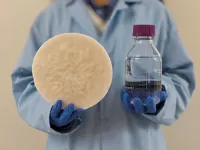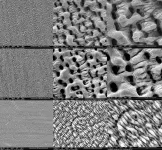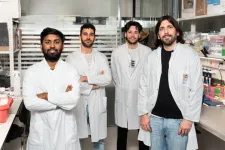(Press-News.org) CHICAGO—February 24, 2025—Beacon Technology Solutions (Beacon), with collaborators at Illinois Institute of Technology (Illinois Tech), has been awarded a grant to support a novel study on how Far-UVC technology can help mitigate the spread of infectious diseases in public spaces. The grant was awarded through the Illinois Innovation Vouchers (IIV) Program, which fosters research collaborations between small- and medium-sized enterprises and Illinois’ world-class universities.
Beacon’s flagship product is a wall-mounted smart disinfection device that uses Far-UVC 222nm light, which has been shown to disinfect up to 99.99 percent of viruses, bacteria, and mold in bench-scale tests. Far-UVC light is a narrow subset of the UVC spectrum (100–280 nm) that has been shown to effectively inactivate pathogens—including coronaviruses and influenza—without penetrating the outer layer of human skin or eyes, making it safer for occupied environments. By deploying Beacon’s proprietary technology in health care facilities and other indoor settings, users may reduce the risk of disease transmission.
“We are thrilled to collaborate with Illinois Tech to bring Beacon’s cutting-edge, safe, and effective pathogen disinfection solution to the front lines of public health,” says Beacon CEO Brian Clark. “This research will help us optimize how our novel technology is deployed in real-world settings. Ultimately, our collaboration aims to make communities across Illinois—and beyond—healthier, more resilient, and better prepared to mitigate the spread of infectious diseases and limit harm using new, non-invasive, and cutting-edge technologies."
The joint research project will combine computational fluid dynamics (CFD) simulations with experimental measurements to understand how bench-scale results translate to real-world environments by analyzing airflow patterns, aerosol distributions, and their interactions with Beacon’s Far-UVC field. The goal is to further analyze the impact of how Beacon’s technology influences aerosol behavior and UV exposure levels, informing best practices for installation, placement, and operation. These insights will enable a more targeted, effective use of Far-UVC disinfection, strengthening Chicago’s and Illinois’ position as leaders in health innovation and safer indoor environments.
“Illinois Tech is excited to collaborate with Beacon on this project to leverage our expertise,” says Associate Professor of Architectural Engineering Mohammad Heidarinejad. “Our team brings a range of expertise to this project, including Brent Stephens, professor, department chair, and Arthur W. Hill Endowed Chair in Sustainability, specializing in indoor air quality; Deborah Steimel-Clair, associate teaching professor, an expert in lighting and building electrical systems; and Saeed Farhood, a Ph.D. student in architectural engineering, specializing in computational fluid dynamics.”
The project’s final report, expected later in 2025, will outline key findings of the research and practical recommendations for utilizing Far-UVC technology. Together, Beacon and Illinois Tech aim to enhance public health resilience, reinforce Illinois’ leadership in innovation, and pave the way toward a future where safer, healthier indoor spaces are the norm.
“Illinois Tech is committed to fostering an innovative environment where promising entrepreneurs can collaborate with academic researchers, and this collaboration with Beacon is an embodiment of this aspiration,” says Maryam Saleh, executive director of the Ed Kaplan Family Institute for Innovation and Tech Entrepreneurship at Illinois Tech, who facilitated the relationship between Beacon’s founders and faculty members at Illinois Tech. “Beacon’s co-founders have an established track record in entrepreneurship. That, combined with their innovative approach to public health, makes them the kind of forward-thinking venture we are proud to help support. Together we’re demonstrating how university–startup collaborations can drive impactful solutions for communities here in Illinois and around the world.”
END
Beacon Technology Solutions, Illinois Tech awarded grant to advance far-UVC disinfection research
Award from Illinois Innovation Vouchers Program bolsters collaboration between university and startup firm to investigate the interaction of fluid dynamics and Beacon’s proprietary technology
2025-02-25
ELSE PRESS RELEASES FROM THIS DATE:
University of Houston researchers paving the way for new era in medical imaging
2025-02-25
New technology developed by researchers at the University of Houston could revolutionize medical imaging and lead to faster, more precise and more cost-effective alternatives to traditional diagnostic methods.
For years, doctors have relied on conventional 2D X-rays to diagnose common bone fractures, but small breaks or soft tissue damage like cancers often go undetected. More expensive and time-consuming MRI scans are not always suitable for these tasks in these detection or screening settings. Now, Mini Das, Moores professor at UH’s College of Natural Sciences and Mathematics and Cullen College ...
High-tech startup CrySyst provides quality-by-control solutions for pharmaceutical, fine chemical industries
2025-02-25
WEST LAFAYETTE, Ind. — International process systems and operation experts have launched high-tech startup Crystallization Systems Technology Inc. (CrySyst) to streamline processes used by companies in the pharmaceutical and fine chemical industries.
CrySyst’s quality-by-control (QbC) framework addresses crystallization monitoring, modeling and control. The framework is based on research published in the April 15, 2020, and Oct. 5, 2021, issues of the journal Crystal Growth & Design and the Sept. 22, 2022, issue of the journal Industrial & Engineering ...
From scraps to sips: Everyday biomass produces drinking water from thin air
2025-02-25
Discarded food scraps, stray branches, seashells and many other natural materials are key ingredients in a new system that can pull drinkable water out of thin air developed by researchers from The University of Texas at Austin.
This new “molecularly functionalized biomass hydrogels” system can convert a wide range of natural products into sorbents, materials that absorb liquids. By combining these sorbents with mild heat, the researchers can harvest gallons of drinkable water out of the atmosphere, even in dry conditions.
“With ...
Scientists design novel battery that runs on atomic waste
2025-02-25
COLUMBUS, Ohio – Researchers have developed a battery that can convert nuclear energy into electricity via light emission, a new study suggests.
Nuclear power plants, which generate about 20% of all electricity produced in the United States, produce almost no greenhouse gas emissions. However, these systems do create radioactive waste, which can be dangerous to human health and the environment. Safely disposing of this waste can be challenging.
Using a combination of scintillator crystals, high-density materials that emit light when they absorb radiation, and solar cells, the team, led by researchers from The Ohio State University, demonstrated that ambient ...
“Ultra-rapid” testing unlocks cancer genetics in the operating room
2025-02-25
A novel tool for rapidly identifying the genetic “fingerprints” of cancer cells may enable future surgeons to more accurately remove brain tumors while a patient is in the operating room, new research reveals. Many cancer types can be identified by certain mutations, changes in the instructions encoded in the DNA of the abnormal cells.
Led by a research team from NYU Langone Health, the new study describes the development of Ultra-Rapid droplet digital PCR, or UR-ddPCR, which the team found can measure the level of tumor cells in a tissue sample ...
Mimicking shark skin to create clean cutting boards
2025-02-25
WASHINGTON, Feb. 25, 2025 – Keeping work surfaces clean during meat processing is a challenge. Bacteria from meat can attach, grow, and build up to create a biofilm that is difficult to remove, even on stainless steel surfaces used in industrial facilities. It can also aggregate, clumping together into an invisible mass that is stronger than individual cells, making it harder to kill using food-grade antibacterial surface cleaners.
In a paper published this week in Journal of Laser Applications, from AIP Publishing and the Laser Institute of America, researchers from the Hopkirk Research Institute, New Zealand Food Safety Science and Research Centre, ...
Adherence to the Mediterranean diet and obesity-linked cancer risk
2025-02-25
About The Study: The findings of this study indicate that higher adherence to the Mediterranean diet is associated with a modest reduction in the risk of obesity-related cancers, independent of adiposity measures. Further research is needed to clarify the mechanisms by which the Mediterranean diet may contribute to cancer prevention.
Corresponding Author: To contact the corresponding author, Inmaculada Aguilera-Buenosvinos, PhD, email iaguilerabuenosvinos@gmail.com.
To access the embargoed study: Visit our For The Media website at this link https://media.jamanetwork.com/
(doi:10.1001/jamanetworkopen.2024.61031)
Editor’s Note: Please see the ...
New technique reveals how the same mutations give rise to very different types of leukaemia
2025-02-25
Barcelona, 25 February 2025 - Myeloid leukaemias are among the most aggressive blood cancers and have low survival rates. Today, leukaemia patients undergo genetic analysis to identify mutations and select the most appropriate treatment. However, even among patients with the same mutation, disease progression and response to therapy can vary significantly.
A study led by ICREA researcher Dr. Alejo Rodríguez-Fraticelli at IRB Barcelona, and funded by Fundación CRIS contra el cáncer, has now revealed these differences can be explained by the fact that not all blood stem cells ...
New insights into how gut cells respond to bacterial toxins
2025-02-25
Researchers from the Organoid group at the Hubrecht Institute have found that specific gut cells, BEST4/CA7+ cells, regulate electrolyte and water balance in response to bacterial toxins that cause diarrhea. Their findings, published in Cell Stem Cell, show that these cells greatly increase in number when exposed to the cytokine interferon-γ (IFNγ), presenting a promising target for therapeutic strategies.
In the gut, a variety of cell types collaborate to keep a balance of electrolyte and water. Bacterial infections can disrupt this balance, leading ...
Designing self-destructing bacteria to make effective tuberculosis vaccines
2025-02-25
Working toward more effective tuberculosis (TB) vaccines, researchers at Weill Cornell Medicine have developed two strains of mycobacteria with "kill switches" that can be triggered to stop the bacteria after they activate an immune response. Two preclinical studies, published, Jan. 10 in Nature Microbiology, tackle the challenge of engineering bacteria that are safe for use in controlled human infection trials or as better vaccines. While TB is under control in most developed countries, the disease still kills over a million people a year worldwide.
Spreading easily through ...
LAST 30 PRESS RELEASES:
Making lighter work of calculating fluid and heat flow
Normalizing blood sugar can halve heart attack risk
Lowering blood sugar cuts heart attack risk in people with prediabetes
Study links genetic variants to risk of blinding eye disease in premature infants
Non-opioid ‘pain sponge’ therapy halts cartilage degeneration and relieves chronic pain
AI can pick up cultural values by mimicking how kids learn
China’s ecological redlines offer fast track to 30 x 30 global conservation goal
Invisible indoor threats: emerging household contaminants and their growing risks to human health
Adding antibody treatment to chemo boosts outcomes for children with rare cancer
Germline pathogenic variants among women without a history of breast cancer
Tanning beds triple melanoma risk, potentially causing broad DNA damage
Unique bond identified as key to viral infection speed
Indoor tanning makes youthful skin much older on a genetic level
Mouse model sheds new light on the causes and potential solutions to human GI problems linked to muscular dystrophy
The Journal of Nuclear Medicine ahead-of-print tip sheet: December 12, 2025
Smarter tools for peering into the microscopic world
Applications open for funding to conduct research in the Kinsey Institute archives
Global measure underestimates the severity of food insecurity
Child survivors of critical illness are missing out on timely follow up care
Risk-based vs annual breast cancer screening / the WISDOM randomized clinical trial
University of Toronto launches Electric Vehicle Innovation Ontario to accelerate advanced EV technologies and build Canada’s innovation advantage
Early relapse predicts poor outcomes in aggressive blood cancer
American College of Lifestyle Medicine applauds two CMS models aligned with lifestyle medicine practice and reimbursement
Clinical trial finds cannabis use not a barrier to quitting nicotine vaping
Supplemental nutrition assistance program policies and food insecurity
Switching immune cells to “night mode” could limit damage after a heart attack, study suggests
URI-based Global RIghts Project report spotlights continued troubling trends in worldwide inhumane treatment
Neutrophils are less aggressive at night, explaining why nighttime heart attacks cause less damage than daytime events
Menopausal hormone therapy may not pose breast cancer risk for women with BRCA mutations
Mobile health tool may improve quality of life for adolescent and young adult breast cancer survivors
[Press-News.org] Beacon Technology Solutions, Illinois Tech awarded grant to advance far-UVC disinfection researchAward from Illinois Innovation Vouchers Program bolsters collaboration between university and startup firm to investigate the interaction of fluid dynamics and Beacon’s proprietary technology





